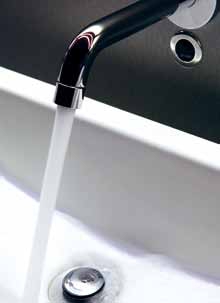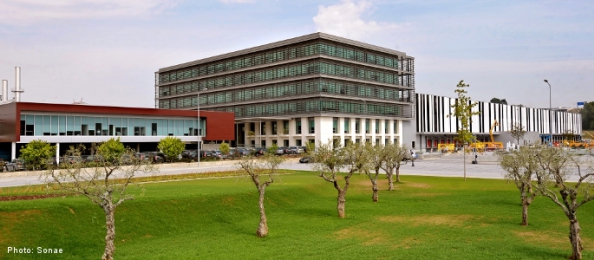A Green Building Inspired by the Future
In an innovative way, Sonae manages to leverage the environmental performance in its various activities, believing that the preservation of the environment is an essential condition for the sustained and sustainable development of its businesses. A reflection of this culture of sustainability is Sonae’s decision in 2004 to participate in the UN Global Compact and adhere to its Ten Principles, thereby accepting the challenge of fully developing practices consistent with global sustainable development.
Aware that all human actions lead to impacts on the environment, Sonae – as an agent of reference in the value chain of markets where it is present – identifies the environmental performance of its activities, products, and services as a corporate priority of its social responsibility. Sonae’s buildings, as factors with environmental impact of extreme relevance, reflect this conviction that an excellent environmental performance translates into an eco-efficient management of natural resources. The challenge of designing a sustainable building in a balanced manner guided the sustainability strategy of the construction of the Sonae Maia Business Center (SMBC). This is the first building on the Iberian Peninsula to be awarded the LEED Gold Design certification (Leadership in Energy and Environmental Design), awarded by US GBC (United States Green Building Council), one of the most prestigious certification agencies for sustainable real estate projects in the world. This distinction reflects the exemplary eco-efficient character of this complex with over 16,000 sq meters, which includes offices and support services of the Retail area of Sonae in the Business Park located in Maia, Portugal. Designed and built with the most advanced environmentally efficient technologies, according to LEED methodology guidelines, the Sonae Maia Business Center is capable of offering its occupants a healthy and comfortable indoor environment, while guaranteeing respect for natural resources through the implementation of effective measures to minimize environmental impact regarding energy and water consumption and waste recovery.
The most innovative green practices
Through an intelligent lighting system that adjusts automatically depending on the conditions of natural light and occupancy, it was possible to reduce the consumption of indoor lighting by 50 percent in the building. Also contributing to the energy efficiency of the Sonae Maia Business Center are the lifts – equipped with an advanced system of route management, guaranteeing faster movement between floors – and the heating and cooling mechanisms of the building, powered by the surplus heat from an industrial process of generating electricity. In the SMBC, the consumption of drinking water is 40 percent lower than in a conventional building with the same type of use. Efficient equipment is utilized such as low-flow taps with infrared automatic control, in addition to a system of recycling sink and shower water, which after going through a treatment system is 100 percent recycled and used as toilet water. Using the roof of the building as an enormous “basin” to collect rainwater for use in irrigation and washing also contributes to reducing water consumption and provides a 95 percent decrease in rainwater flow in the event of heavy rain, minimizing the risk of flooding. With regards to waste recovery, it is worth highlighting that from the waste resulting from the construction, 90 percent was reused or recycled on site and 95 percent of the wood used comes from sustainably managed forests. Additionally, the Sonae Maia Business Center is equipped with priority parking for eco-efficient vehicles and has a bus that connects the building to the nearest underground stations.

Healthy indoor environment
The comfort and well-being of the occupants are key aspects of the indoor environment of the Sonae Maia Business Center. There are 650 permanent employees and 600 occasional employees who work here on a daily basis. Of these, 95 percent have access to natural light and outdoor views. Thus, they can feel the changes in daylight and “roam” through the landscape, which is essential to the comfort of the employees and beneficial to their health. Worth emphasizing are the acoustics of the building, the impact of which is minimized by a system of silent air conditioning units. One hundred percent of paints, glues, sealants, and carpets have very low levels of harmful chemicals. Also, highly efficient filters guarantee the cleanliness of inhaled air and provide a high indoor air quality. Also noteworthy is the existence of a pressurized space to keep polluted air from the parking lots traveling inside the building.
Pioneer culture of sustainability
From early on, Sonae’s environmental performance has been integrated into the overall management of the company, with eco-efficiency serving as a management benchmark. Apart from being the leader in the retail sector in Portugal, Sonae aims to lead the sector in matters related to the environment, implementing and driving the adoption of best environmental management practices through example. Since the genesis of the company 50 years ago, sustainability has been a long-term commitment of Sonae. This became evident when the company chose to commit to the Ten Principles of the UN Global Compact in 2004. The application of the Principles in the various activities of the business is a constant challenge, and at the same time an essential factor in achieving high standards and continuous improvement. Over the years, Sonae has sought to find balance in trying to achieve economic development, social responsibility, and environmental protection by promoting a culture of ethics, truth, justice, and respect for all of those with whom it interacts – clients, employees, and suppliers.
The LEED Gold certification
Currently over 30,000 buildings are registered as certified in over 100 countries. When the Sonae Maia Business Center was certified in 2010, only 1,700 buildings, which corresponds to 5 percent, had achieved GOLD status from the greatest internationally recognized system for evaluating environmental merit. To accomplish this level of certification, the building had to adhere to dozens of requirements regarding five dimensions fundamental to environmental sustainability: Energy and Atmosphere, Water Efficiency, Materials and Resources, Sustainable Sites, and Indoor Environmental Quality. After a process of selecting the prerequisites that were best-suited to the environmental and economic context of the region, an eco-friendly building was constructed that was capable of offering its occupants a healthy, comfortable, and attractive indoor environment that respects natural resources.
About Us // Privacy Policy // Copyright Information // Legal Disclaimer // Contact
Copyright © 2012-2018 macondo publishing GmbH. All rights reserved.
The CSR Academy is an independent learning platform of the macondo publishing group.









